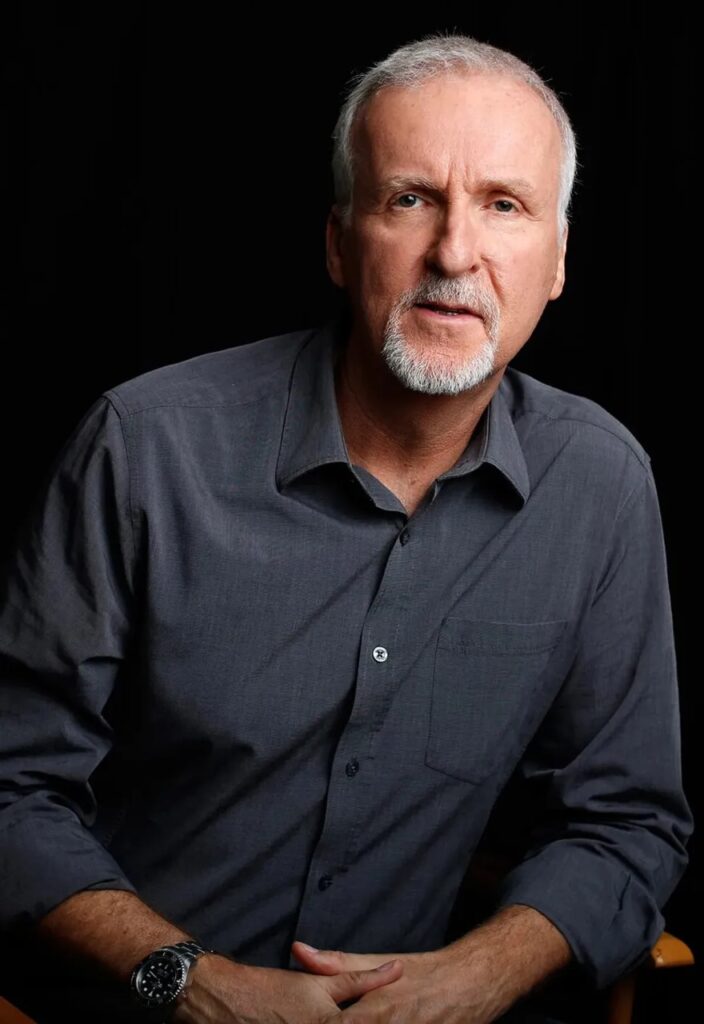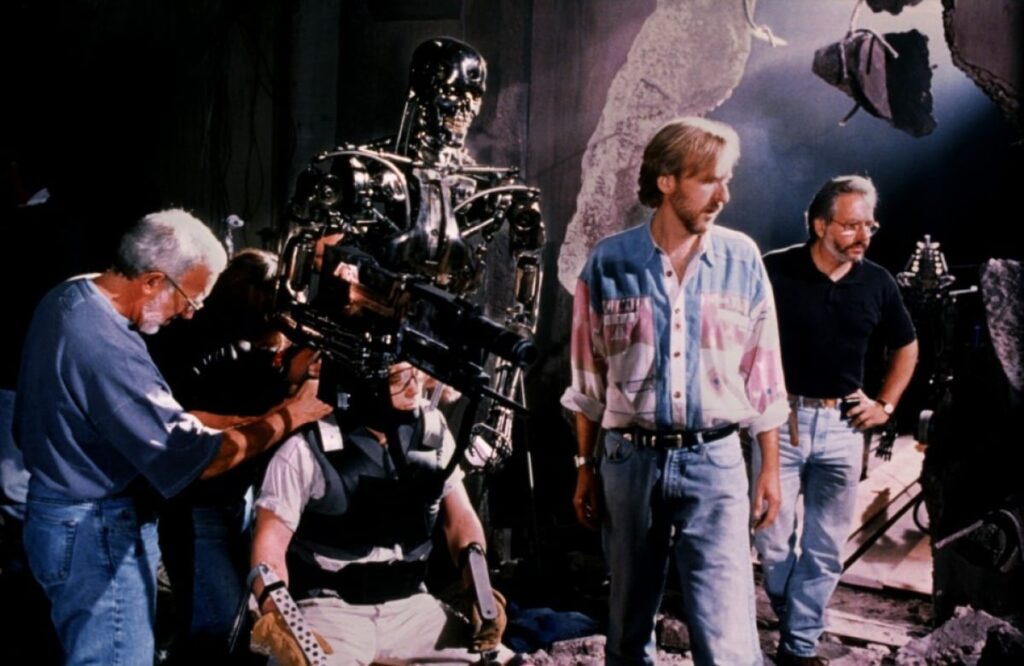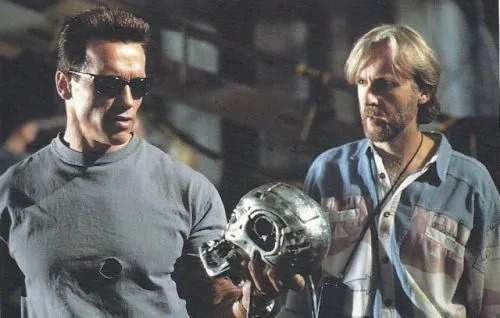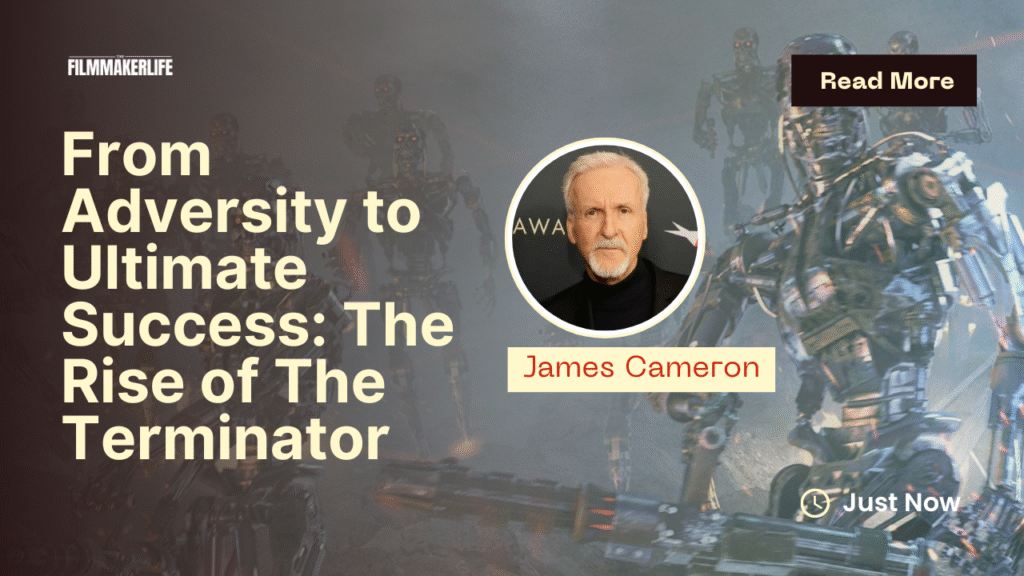When Adversity Sparks Genius
In the early 1980s, James Cameron faced one of the lowest points in his life. Broke, sick, and sleeping on a friend’s couch, he felt the weight of failure pressing down on him. Yet, in that moment of despair, a nightmare sparked a creative vision that would change cinema forever. In his fevered dream, Cameron saw a metallic skeleton rising from flames, an image that would become the foundation of The Terminator. This story is not just about a film—it’s about turning struggle into innovation and proving that even the hardest moments can inspire greatness. In this article, we explore Cameron’s journey, the making of the iconic film, and the cultural legacy it left behind.

James Cameron
The Birth of a Vision
James Cameron’s idea for The Terminator came during a challenging period while he was in Rome. Battling food poisoning and exhaustion, Cameron experienced a vivid nightmare of a cyborg emerging from fire. He immediately grabbed a pen and hotel stationery to sketch what he saw. This early image became the blueprint for what would later be one of the most influential science fiction films of all time. Cameron drew inspiration from low-budget horror films like John Carpenter’s Halloween, demonstrating that creativity could thrive even without massive resources.
At this point, Cameron had directed only one short film and a few low-budget projects. He was determined to tell a story that combined the suspense of horror with the futuristic imagination of science fiction. The Terminator’s relentless, unstoppable nature reflected both Cameron’s fascination with technology and his own sense of urgency to succeed.
Overcoming Obstacles: Producing The Terminator
Turning a fever dream into a feature film was no easy task. Cameron sold the rights to The Terminator for just $1 to get the opportunity to direct it. His commitment and determination were crucial, but the challenges didn’t stop there. The budget was limited, forcing the crew to get creative with special effects, set designs, and stunts. Every dollar had to be maximized, making the production a test of ingenuity.
Casting was another major hurdle. Initially, Arnold Schwarzenegger was considered for the role of Kyle Reese, but Cameron realized his towering physique made him perfect as the relentless T-800 cyborg. Linda Hamilton was cast as Sarah Connor, bringing depth and strength to a character who would become a symbol of resilience. The dynamic between Hamilton and Schwarzenegger became central to the film’s tension and appeal.
Cameron also pushed the boundaries of practical effects, miniatures, and early animatronics to bring his vision to life. These choices were not only budget-driven but also innovative, setting new standards for science fiction filmmaking.

Themes and Innovation
The Terminator was more than a thrilling chase movie. It explored themes of artificial intelligence, fate, and humanity’s reliance on technology. The film’s portrayal of a future dominated by machines was both chilling and prescient, raising questions about AI ethics long before the topic became mainstream.
Cameron’s storytelling combined suspense, action, and emotional depth. The relentless pursuit by the T-800 mirrored the unstoppable force of human fears and anxieties. Audiences were drawn not only to the thrilling plot but also to the emotional journey of the characters, particularly Sarah Connor’s evolution from a regular woman into a determined survivor.
Casting Legends: Arnold Schwarzenegger and Linda Hamilton
Arnold Schwarzenegger’s role as the Terminator became iconic. His physical presence and minimalistic dialogue created a terrifying yet unforgettable antagonist. Cameron’s vision of a machine that could not be stopped, combined with Schwarzenegger’s imposing figure, defined a new type of action villain.
Linda Hamilton’s portrayal of Sarah Connor broke stereotypes. Rather than being a passive damsel in distress, her character evolved into a symbol of strength and resilience. Hamilton’s performance would influence countless action heroines in cinema for decades.
Michael Biehn, who played Kyle Reese, also delivered a compelling performance as a protector caught in an impossible situation. The casting choices contributed significantly to the film’s success, proving that the right actors can transform even the most challenging projects into cultural milestones.

Production Challenges and Creative Solutions
Budget constraints forced Cameron and his team to innovate. Special effects were often practical, involving miniatures, makeup, and creative camera angles. For instance, the famous scene where the Terminator’s robotic endoskeleton is revealed required meticulous work with prosthetics and animatronics. These efforts paid off, as audiences were mesmerized by the realistic and terrifying visuals.
Cameron’s dedication extended to the film’s pacing and tension. He meticulously storyboarded sequences to maximize suspense while minimizing unnecessary spending. Every scene had a purpose, blending action, horror, and storytelling into a cohesive and compelling narrative.
The Cultural and Cinematic Impact
Released in 1984, The Terminator became a commercial and critical success, grossing over $78 million worldwide on a modest budget. It inspired sequels, TV series, novels, comics, and video games, establishing one of the most successful franchises in film history. The film’s themes of AI, technological advancement, and human resilience resonated with audiences and influenced filmmakers for generations.
Cameron’s success proved that vision and determination could overcome financial and personal obstacles. His ability to translate a nightmare into a groundbreaking film became a case study for aspiring filmmakers worldwide.
James Cameron’s journey from a struggling filmmaker to the creator of The Terminator proves that adversity can fuel creativity. A nightmare became a cinematic revolution, inspiring millions and shaping the future of science fiction. Cameron’s story reminds us that even in our darkest moments, there is potential for brilliance. Challenges are not obstacles—they are opportunities waiting to be transformed into art.

Connect with James Cameron

Creative strategist dedicated to uncovering the stories behind today’s most visionary independent creators. With a background in film marketing and festival programming, Marco writes about cinema, distribution, and the evolving landscape of modern cinema. His work focuses on empowering filmmakers to turn creativity into sustainable careers.

